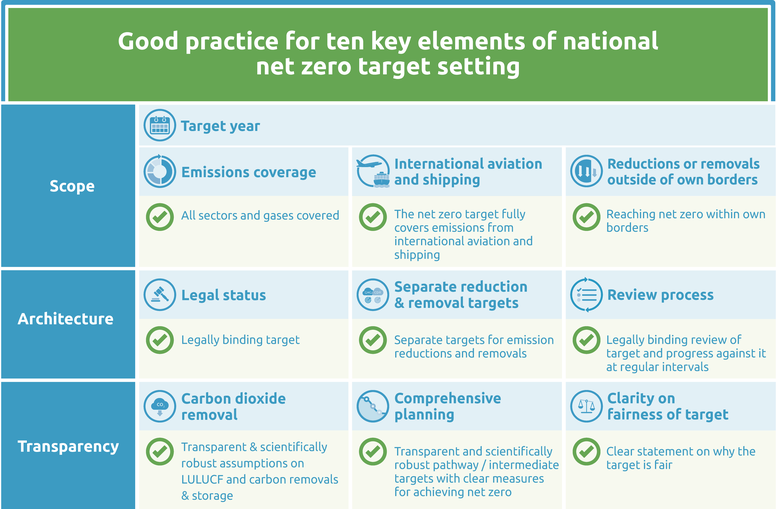Net zero targets
Summary
NOTE: Bhutan submitted a long-term strategy to the UNFCCC in September 2023. The assessment of Bhutan's LTS will be included in the next update.
We evaluate Bhutan’s net zero target as: Target information incomplete.
Bhutan first committed to remaining carbon neutral during COP15 in 2009. In its second NDC, Bhutan adopted a net zero emissions by 2050 indicative target, which it has already met, given that Bhutan is currently a net negative emitter. However, the NDC does not sufficiently detail how Bhutan will monitor this target - and not exceed it in the future.
Bhutan’s second NDC does not provide any clarification on the terms ‘carbon neutral’ and ‘net zero’, but its Climate Change Policy of 2020 defines ‘carbon neutral’ as covering all GHGs, not just CO2 emissions.
Further, Bhutan has adopted four Low Emissions Development Strategies (LEDS), targeting the transport, industrial, human settlement, and food sectors which are instrumental to remain carbon neutral. LEDS of these four sectors provides detail of the measures and their mitigation potential under each timeframe, along with specific investment need up to 2050. Yet, certain sectoral measures evaluate mitigation potential by considering avoided emissions resulting from hydro power to India. It remains unclear the extent of dependency of Bhutan’s net zero target on these avoided emissions.
Bhutan is currently working on its long-term strategy, but had not yet submitted it as of June 2023.
The CAT does not provide an overall rating of Bhutan’s net zero target design, given the lack of more detailed information. We will evaluate the target further once more information becomes available.
CAT analysis of net zero target
Ten key elements
Scope
- Target year – Bhutan adopted a net zero emissions by 2050 target in its second NDC. It has already met this target given that Bhutan is currently a net negative emitter.
- Emissions coverage – Bhutan’s carbon neutrality target covers the three main greenhouse gases (i.e. CO2, CH4, N2O) as these are the most relevant gases in Bhutan. In its first Biennial Update Report, Bhutan reported emissions of HFCs from industrial process but these are less than 1% of Bhutan’s total emissions (Royal Government of Bhutan 2022). Bhutan has not commented on NF3 (Bhutan Government 2021). Bhutan has used the term ‘carbon neutrality’ and ‘net zero’ interchangeably in its NDC but its Climate Change Policy 2020 defines ‘carbon neutral’ as covering all GHGs not just CO2 emissions.
- International aviation and shipping – Bhutan does not provide any information on international aviation and shipping in its target.
- Reductions or removals outside of own borders – Bhutan does not provide information on its intention to use international offset credits to meet its net zero target by 2050. While some of its sectoral LEDS quantify the mitigation potential based on the premise of avoided emissions due to renewable hydropower exports to India, it is unclear whether its economy-wide net zero target of 2050 relies on these avoided emissions (Royal Government of Bhutan 2020a).
Target architecture
- Legal status – Bhutan’s 2050 net zero is included in its second NDC submission (Royal Government of Bhutan 2021). Bhutan is currently preparing its LTS to support this target.
- Separate reduction & removal targets – Bhutan does not provide any information on its intention to communicate separate emission reduction and removal targets. At present, Bhutan is a net negative country and its large-scale forest sinks are fundamental to its 2030 carbon neutrality target and its 2050 net zero target.
- Review process – Bhutan does not provide any information on its intention to establish a review cycle for its net zero and intermediate targets.
Transparency
- Carbon dioxide removal – Bhutan does not provide any information on its intention to communicate transparent assumptions on carbon dioxide removals.
- Comprehensive planning – Bhutan has developed Low Emissions Development Strategies (LEDS) for its transport, industrial, agricultural, and human settlement sectors. The LEDS cover short-term (2025), medium-term (2030), and long-term (2050) time frames against which identified mitigation measures can be achieved. LEDS of these four sectors provides detail of the measures and their mitigation potential under each timeframe along with specific investment need.
- Clarity on fairness of target – Bhutan does not provide any information on its intention to explain the target’s fairness.
Good practices
The Climate Action Tracker has defined the following good practice for all ten key elements of net zero targets. Countries can refer to this good practice to design or enhance their net zero targets.
Further analysis
Latest publications
Stay informed
Subscribe to our newsletter







